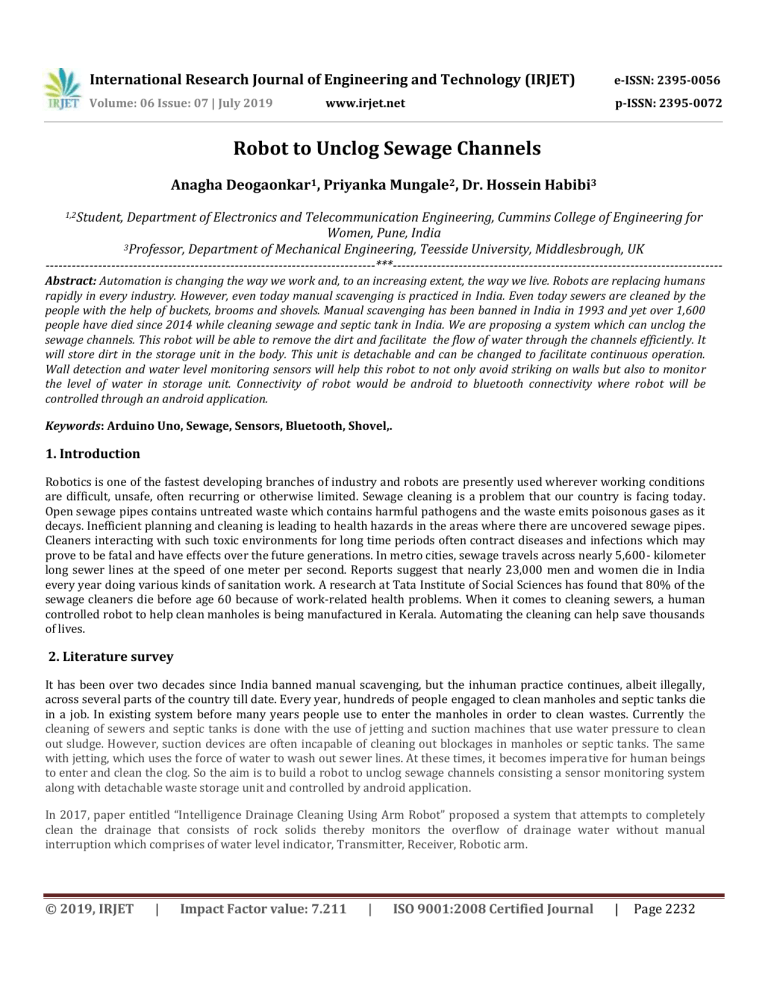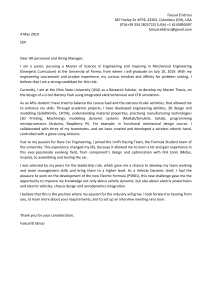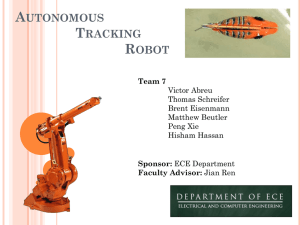IRJET- Robot to Unclog Sewage Channels
advertisement

International Research Journal of Engineering and Technology (IRJET) e-ISSN: 2395-0056 Volume: 06 Issue: 07 | July 2019 p-ISSN: 2395-0072 www.irjet.net Robot to Unclog Sewage Channels Anagha Deogaonkar1, Priyanka Mungale2, Dr. Hossein Habibi3 1,2Student, Department of Electronics and Telecommunication Engineering, Cummins College of Engineering for Women, Pune, India 3Professor, Department of Mechanical Engineering, Teesside University, Middlesbrough, UK ---------------------------------------------------------------------------***--------------------------------------------------------------------------Abstract: Automation is changing the way we work and, to an increasing extent, the way we live. Robots are replacing humans rapidly in every industry. However, even today manual scavenging is practiced in India. Even today sewers are cleaned by the people with the help of buckets, brooms and shovels. Manual scavenging has been banned in India in 1993 and yet over 1,600 people have died since 2014 while cleaning sewage and septic tank in India. We are proposing a system which can unclog the sewage channels. This robot will be able to remove the dirt and facilitate the flow of water through the channels efficiently. It will store dirt in the storage unit in the body. This unit is detachable and can be changed to facilitate continuous operation. Wall detection and water level monitoring sensors will help this robot to not only avoid striking on walls but also to monitor the level of water in storage unit. Connectivity of robot would be android to bluetooth connectivity where robot will be controlled through an android application. Keywords: Arduino Uno, Sewage, Sensors, Bluetooth, Shovel,. 1. Introduction Robotics is one of the fastest developing branches of industry and robots are presently used wherever working conditions are difficult, unsafe, often recurring or otherwise limited. Sewage cleaning is a problem that our country is facing today. Open sewage pipes contains untreated waste which contains harmful pathogens and the waste emits poisonous gases as it decays. Inefficient planning and cleaning is leading to health hazards in the areas where there are uncovered sewage pipes. Cleaners interacting with such toxic environments for long time periods often contract diseases and infections which may prove to be fatal and have effects over the future generations. In metro cities, sewage travels across nearly 5,600- kilometer long sewer lines at the speed of one meter per second. Reports suggest that nearly 23,000 men and women die in India every year doing various kinds of sanitation work. A research at Tata Institute of Social Sciences has found that 80% of the sewage cleaners die before age 60 because of work-related health problems. When it comes to cleaning sewers, a human controlled robot to help clean manholes is being manufactured in Kerala. Automating the cleaning can help save thousands of lives. 2. Literature survey It has been over two decades since India banned manual scavenging, but the inhuman practice continues, albeit illegally, across several parts of the country till date. Every year, hundreds of people engaged to clean manholes and septic tanks die in a job. In existing system before many years people use to enter the manholes in order to clean wastes. Currently the cleaning of sewers and septic tanks is done with the use of jetting and suction machines that use water pressure to clean out sludge. However, suction devices are often incapable of cleaning out blockages in manholes or septic tanks. The same with jetting, which uses the force of water to wash out sewer lines. At these times, it becomes imperative for human beings to enter and clean the clog. So the aim is to build a robot to unclog sewage channels consisting a sensor monitoring system along with detachable waste storage unit and controlled by android application. In 2017, paper entitled “Intelligence Drainage Cleaning Using Arm Robot” proposed a system that attempts to completely clean the drainage that consists of rock solids thereby monitors the overflow of drainage water without manual interruption which comprises of water level indicator, Transmitter, Receiver, Robotic arm. © 2019, IRJET | Impact Factor value: 7.211 | ISO 9001:2008 Certified Journal | Page 2232 International Research Journal of Engineering and Technology (IRJET) e-ISSN: 2395-0056 Volume: 06 Issue: 07 | July 2019 p-ISSN: 2395-0072 www.irjet.net Research paper entitled “Drainage Cleaning Robot” proposes a special conveyor system, D.C motor, D.C battery and drainage waste storage box equipment’s to work as automatic drainage cleaning system. The device is placed across an open drain floating waste like bottles, plastic cans, covers etc. is lifted by lifters which are connected to the conveyor. 3. Proposed System There exist open channels where sewage water can accumulate and this affects the people nearby. The motivation of this project is to reduce manual cleaning of this sewage channels to reduce serious illness issue by automation of sewage cleaning method using android application and sensor technology to monitor the system. System design consists of various sections: ● Cleaning. ● Storage unit. ● Connectivity. ● Monitoring System. 3.1. Cleaning: The cleaning process is carried out with the help of blade which is made of two parts: 1. Main drill bit with teeth to cut through. 2. An rotational actuator with pads fit at an angle for removal of dirt. 3.2. Storage Unit: The body will itself act as a storage device. It will be lined from inside with waterproof layers so that we minimize the risk of any water damage. A wide shovel will be attached to the body with 90 degrees of rotation and a mesh to drain out water so that only dirt will be stored. After operation, the storage unit can be removed to remove the dirt. 3.3. Connectivity: Bluetooth Connectivity: © 2019, IRJET | Impact Factor value: 7.211 | ISO 9001:2008 Certified Journal | Page 2233 International Research Journal of Engineering and Technology (IRJET) e-ISSN: 2395-0056 Volume: 06 Issue: 07 | July 2019 p-ISSN: 2395-0072 www.irjet.net Robot will be controlled using a bluetooth module (HC05) through an android application. Various operations like switching controls, turning on/off specific task will be carried out. This module will be interfaced with a microcontroller for transmitting and receiving data. 3.4. Monitoring System: To monitor the whole procedure interfacing of sensors with microcontroller is one to make system more precise. 3.4.1. Ultrasonic Sensor: Ultrasonic sensors are used for wall detection. During the motion of bot this would avoid the striking of bot to the walls, which increases bot’s durability. Ultrasonic sensors work by emitting sound waves at a frequency too high for humans to hear. They then wait for the sound to be reflected back, calculating distance based on the time required. Mostly used for robot navigation system. 3.4.2. Water level detector: Water level will be monitored using water level sensor. It will give an indication as water level in the storage unit exceeds the limit. Water level sensor can be used to identify the point at which a liquid falls below a minimum or rises above a maximum level. 4. Hardware Requirements 4.1. Arduino Uno: Arduino Uno is programmed usinduino g ArSoftware which is a cross-platform application called IDE written in Java. The AVR microcontroller Atmega328 laid out on the base comes with builtin bootloader that sets you free from using a separate burner to upload the program on the board. Arduino UNO is an open-source microcontroller board based on the Microchip ATmega328P microcontroller and developed by Arduino.cc. The board is equipped with sets of digital and analog input/output (I/O) pins that may be interfaced to various expansion boards (shields) and other circuits. The board has 14 Digital pins, 6 Analog pins, and programmable with the Arduino IDE (Integrated Development Environment) via a type B USB cable. It can be powered by a USB cable or by an external 9 volt battery, though it accepts voltages between 7 and 20 volts. 4.2. Bluetooth Module(HC05): It is a PAN (Personal Area Network device) used for short distance of conversation. Bluetooth Module Features Support Master & Slave Mode Serial communications and it works with Frequency: 2.4~2.524 GHz. Over the designing of the Wi-Fi security lock device, we are ideally using the HC-05 module. HC-05 is smooth to integrate with Arduino and provide safety parameters earlier than connecting device. But there may be an issue with Bluetooth HC-05 Like the default password and baud price needs to be changed, otherwise it might be easy to unauthorizers having access to Our safety tool ,So with the help of AT commanding can be configured with desired password and person names. 4.3. Servo Motor(SG90): Tiny and lightweight with high output power. Servo can rotate approximately 180 degrees (90 in each direction), and works just like the standard kinds but smaller. You can use any servo code, hardware or library to control these servos. Good for beginners who want to make stuff move without building a motor controller with feedback & gear box, especially since it will fit in small places. It comes with a 3 horns (arms) and hardware. © 2019, IRJET | Impact Factor value: 7.211 | ISO 9001:2008 Certified Journal | Page 2234 International Research Journal of Engineering and Technology (IRJET) e-ISSN: 2395-0056 Volume: 06 Issue: 07 | July 2019 p-ISSN: 2395-0072 www.irjet.net 4.4 .Ultrasonic Sensor (HC-SR04): HC-SR04 is an ultrasonic ranging module that provides 2 cm to 400 cm non-contact measurement function. The ranging accuracy can reach to 3mm and effectual angle is < 15°. It can be powered from a 5V power supply. 4.5. Water Level Indicator: The metal strips of the sensor have resistance. When in touch with water current will flow. Depending on how deep it is in the water, resistance will vary and help us to detect the level of water. 4.6. Mechanical Design: 4.6.1. Legs: There will be four compliant C shaped legs made out of aluminium. Legs will be driven by servo motors. Compliant C shaped legs make it easier for the bot to move through the dirt and allow the robot to move on any terrain. 4.6.2. Blade: The blade has a pointed front with teeth and then a shaft with fins fitted at a suitable angle. The pointed front with the teeth helps blade penetrate through the dirt and the fins help in moving the dirt out of the way. The blade will be driven by a servo motor. There will be a linear actuator to move the shaft laterally. 4.6.3. Storage Unit: The dirt that is moved by the fins needs to be collected. The storage unit will have a tray that will slide in and out of the body. The inner walls will be lined with rubber so to minimize the risk of any water damage to the robot. A pan attached to the front of the body with the help of hinges, that will move on the floor collect the dirt. The pan will moves in semi-circular fashion to dump dirt into the storage tray. 4.6.4. Body: The aluminium body will be light-weight and will provide support to the structure. 5. Software Requirements 5.1. Arduino IDE: The Arduino integrated development environment (IDE) is a cross-platform application(for Windows, macOS, Linux) that is written in the programming language Java. It is used to write and upload programs to Arduino compatible boards, but also, with the help of 3rd party cores, other vendor development boards. The source code for the IDE is released under the GNU General Public License, version The Arduino IDE supports the languages C and C++ using special rules of code structuring. The Arduino IDE supplies a software library from the Wiring project, which provides many common input and output procedures. User-written code only requires two basic functions, for starting the sketch and the main program loop, that are compiled and linked with a program stub main() into an executable cyclic executive program with the GNU tool chain, also included with the IDE distribution. 5.2. Android Studio: The mobile application is developed using Android Studio version 3.2. This platform uses Java programming language to design the application. Various libraries can be included as per requirement. 5.3. Proteus Design Suite: The integration of electronics components i.e sensors, microcontroller, motors and its simulation is done using proteus design suite. 6. Conclusion Considering the severe problem regarding the sewage cleaning, the proposed concept can contribute towards reducing the manual scavengers in our country which will reduce health hazards for human thereby reducing the environmental © 2019, IRJET | Impact Factor value: 7.211 | ISO 9001:2008 Certified Journal | Page 2235 International Research Journal of Engineering and Technology (IRJET) e-ISSN: 2395-0056 Volume: 06 Issue: 07 | July 2019 p-ISSN: 2395-0072 www.irjet.net pollution in our country. The proposed system is time-efficient and customer friendly. Minimal cost and labour would be required in the implementation of the system. References [1] Ultrasonic Ranging Module HC - SR04 Datasheet. Micropik, 2005. [2] “Arduino,”Arduino. [Online]. Available at: https://www.arduino.cc/en/. [3] S.Sharmili, T. Saarika and R.Malar “intelligence Drainage Cleaning Using Arm Robot” ISSN: 0976-1353 Volume 24 Issue 7– APRIL 2017 [4] “An Autonomous Robotic System to Maintain Free Flowing Drains” by Joy Costa, Md. Sayeem Chowdhury, Istiak Ahmed Inam. © 2019, IRJET | Impact Factor value: 7.211 | ISO 9001:2008 Certified Journal | Page 2236


